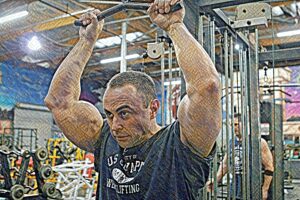
Strength Sensei 101
Rate of Exercise Variation
More insights into the pioneering training methods of Charles R. Poliquin
How often should you change exercises? Expanding on this question, what constitutes a change of exercise? Is a back squat with the heels elevated enough of a change, or do you need to go more extreme, such as with a front squat or a leg press. The Strength Sensei has some strong opinions on this topic.
Through his books and articles, Fred “Dr. Squat” Hatfield helped popularize the idea that the upper body requires more frequent variation in exercise prescription than the lower body. [Hatfield, F., Hardcore Bodybuilding: A Scientific Approach, 1993, Chapter 7, Contemporary Books, Inc.]
As the Strength Sensei did in his early years, Hatfield would divide the body into three parts: 1) upper body, 2) lower body, and 3) midsection, calves, and forearms. He would then take it a step further by separating trainees into fast gainers (those with more fast twitch muscle fibers) and slow gainers.
Let’s say we have a six-week training cycle. For the legs, you might do dumbbell split squats for three weeks, followed by barbell back squats for three weeks. For the shoulders, you might do barbell behind-the-neck presses for two weeks, lean-away dumbbell lateral raises for two weeks, and barbell military presses for two weeks. But as the Strength Sensei said, “There’s optimal training, and then there’s reality.”
Although understanding the recovery periods needed for the upper and lower body is a good start, many other variables are worth considering. Here are nine training guidelines the Strength Sensei proposed on exercise variation:
- To prevent training plateaus, only minor changes in exercise variation are necessary. A simple change in foot stance or grip constitutes an adequate change to prevent adaptation. For example, an athlete performing back squats does not need to make a radical switch to a leg press but could perform a front squat or even a heel’s elevated back squat. Likewise, when it’s time to switch after a training period using bench presses, incline presses or log presses could be performed.
- Beginners can perform the same exercises for considerably longer periods. Training age is not necessarily associated with chronological age. For example, in their first year of training, a beginner may make optimal progress performing the same exercises for two months. For two years, the rate of change may be 4-6 weeks, and for three years, 2-4 weeks.
- Poorly trained individuals need longer to adapt to exercise variation. If an individual is making little progress (such as with a lack of effort or a poor diet), they cannot change their exercises as frequently as those who train hard.
- Changing exercises too frequently is counterproductive. If a beginner were to change their exercises every week, they would not experience optimal results. Therefore, keeping detailed records of your program is essential to determine when exercise change is needed.
- Those with a higher percentage of fast-twitch muscle fibers adapt to exercise variations faster. This guideline is in agreement with Hatfield’s writings. The Strength Sensei estimated that approximately 11 percent of the elite athletic population could adapt to changes daily and less for the average population. This is also why the high-volume workouts of the champion bodybuilders published in popular muscle magazines are often inappropriate for the average trainee.
Weightlifting coach Carl Miller was one of the Strength Sensei’s favorite authors. In the 70s, Miller discussed how lower-class weightlifters from Eastern Bloc countries would perform only two categories of leg exercises: Front Thigh, Hip and Upper Thigh. Elite athletes would perform five: Front Thigh, Hip and Upper Thigh, Speed, Deep Penetrating, and Specialized Pull. (Miller, Carl. Olympic Lifting: A Training Manual, 1977, reprint 2018, pp. 67-76, Sunstone Press.)
- Hormonal factors influence how quickly an individual responds to training. As any vampire would tell you, the blood doesn’t lie. For example, an individual on hormonal replacement theory may need a more frequent exercise change.
- Varied, effective programs motivate you to train harder. Caffeine-loaded sports drinks can only do so much. You need to look forward to your workouts to train hard, and staying with the same exercises for too long can make the workouts boring.
- For athletes, the off-season length influences the exercise change rate. If an athlete has a relatively long off-season, such as a football player, their rate of exercise change can be less frequent. If the off-season is relatively short, such as with NHL (especially those who compete long into the playoffs), the rate of change is shorter.
- The in-season physical demands of a sport influence the rate of exercise change. In many sports, especially gymnastics where the training could be considered sports-specific strength training, the rate of exercise change should be less frequent. In the Strength Sensei’s work with the Canadian National Ski Team, he found that little leg work was required to maintain the strength of the quads during the season. The alpine skier would need to train quads less frequently, and thus the time between changing exercises would be longer.
When looking at training programs, consider that many factors determine the rate of change in exercise. Use the guidelines, keep accurate records, and take a flexible approach to program design. (TSS)
